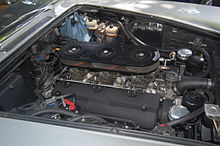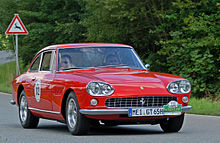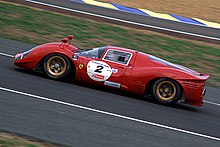Ferrari 330
The Ferrari 330 is a model family of the Italian car manufacturer Ferrari , built from 1962 to 1968, which included street sports cars and competition vehicles . Together with the Ferrari 275 , the 330 served as the successor to the Ferrari 250 . The 330 was in turn replaced by the Ferrari 365 . The model family includes the 330 America , 330 GT 2 + 2 (Coupés) and 330 GTC / GTS (Coupé and Spyder) road sports cars as well as the 330 TR / LM , 330 GTO , 330 LMB and 330 P racing vehicles designed for the prototype class . All 330 models were powered by differently constructed twelve-cylinder engines with a displacement of 4.0 liters. The model name is derived from this and refers to the (rounded) cubic capacity of a single cylinder (approx. 330 cm³). Apart from this technical commonality, the individual models in the family differ considerably in terms of chassis and body.
The motors
The vehicles in the 330 model family have different twelve-cylinder engines with a displacement of 4.0 liters. All engine variants go back to the engineer Gioacchino Colombo , who in 1947 designed a twelve-cylinder block for Ferrari with a cylinder bank angle of 60 degrees and initially only 1.5 liters displacement. Ferrari has been using this so-called Colombo or short block engine since 1948 with different displacements of 2.0 liters and more in various street sports cars.
Tipo 163
The so far last expansion stage of the Colombo engine was the Tipo 163 presented in 1960 , whose displacement was 3967 cm³ (bore × stroke = 77 × 71 mm). In this version, the cylinders were still at a distance of 90 mm, which Colombo had already determined in 1947. The Tipo 163, which in the street version developed 340 HP (250 kW) at 7,000 revolutions per minute, was used in the 400 Superamerica from 1960 . In the winter of 1961/62, three road sports cars were built on a trial basis in which a reduced-power version of this engine type with 300 hp (221 kW) at 6,600 rpm was combined with the chassis of the 250 GT 2 + 2. From 1962, higher-performance variants of this engine found their way into some racing sports cars, which were also given the model designation 330 with regard to the individual cylinder volume of 330 cm³.
Tipo 209
The twelve-cylinder Tipo 209 engine is to be distinguished from this . It is also based on the Colombo engine and has the same ratio of bore and stroke (and thus the same displacement) as the Tipo 163. The cylinder block, however, was redesigned. The cylinder bank angle remained unchanged at 60 degrees, but the cylinder spacing (pitch) was increased from 90 to 94 mm. As a result, Ferrari achieved an improvement in the cooling circuit. At the same time, the engine block was lengthened by around 50 mm and the weight increased by 25 kg. Each row of cylinders still had an overhead camshaft, and each cylinder had two valves.
The Tipo 209 was used in the street sports cars of the 330 model family with the exception of the three test vehicles.
Tipo 216, 216B and 237
Further modifications of the 4.0-liter V12 engine were the Tipo 216 , 216B and 237 variants for the mid-engined racing sports cars 330 P2 (1965), 330 P3 (1966) and 330 P4 (1967). With the same cylinder dimensions, the racing versions are characterized by new cylinder heads with DOHC valve control , double ignition and dry sump lubrication . The Tipo 216 had six twin carburettors, but despite DOHC control only two valves per cylinder. The Tipo 216B, like the 216 developed under Mauro Forghieri , had an intake manifold injection from Lucas and a significantly increased compression for the first time . In the last evolutionary stage, for which Franco Rocchi was responsible, the engine, now known as Tipo 237, received new cylinder heads with three valves per cylinder (two intake and one exhaust valve) as well as targeted reinforcements, as in the contemporary Ferrari Formula 1 vehicles to take on a supporting role. The power increased to up to 450 hp (331 kW) at 8,000 revolutions per minute and more.
The street models
Under the model designation 330, Ferrari offered three different street sports cars with coupé and convertible bodies from 1963 to 1968, each of which had Pininfarina bodies at the factory . In addition, some individual pieces were built with bodies by other designers. Three test vehicles had already been built in the winter of 1961/62 in which the chassis of the 250 GT 2 + 2 was combined with the Tipo 163 engine (chassis numbers 2947GT, 3105GT and 4085). The first vehicle was temporarily owned by Enzo Ferrari.
330 America (1963)
The Ferrari 330 America presented in 1963 was a transitional model that is "almost forgotten" today. It was Ferrari's first road vehicle to be fitted with the 4.0 liter twelve-cylinder Tipo 209 engine. In this model, Ferrari combined the new engine with the body of the 250 GTE 2 + 2 designed by Pininfarina three years earlier . Both models are externally indistinguishable from each other. The chassis also corresponded to that of the 250 GTE. The America models were equipped with a manual five-speed transmission. Their top speed was around 250 km / h. The cars were built at Pininfarina in the fall of 1963. A total of 50 copies of the 330 America were made.
In early 1964 Ferrari replaced the 330 America with the 330 GT 2 + 2.
330 GT 2 + 2 (1964–1967)
The Ferrari 330 GT 2 + 2 presented in January 1964 replaced the 330 America. The Tipo 209 engine was taken over from the 330 America, but the chassis and body were completely redesigned or redesigned. The 330 GT 2 + 2 had a wheelbase that was 5 cm longer than the 250 GTE 2 + 2. The chassis had an independent wheel suspension at the front, while Ferrari used a rigid axle with leaf springs at the rear. Hydraulic telescopic shock absorbers from Koni were new . The braking system worked with two hydraulic circuits and disc brakes on all wheels. The four-liter engine developed around 220 kW (299 hp) at 7,500 rpm. The power was initially transmitted by a manual four-speed gearbox with overdrive; from 1965 a manual transmission with five forward gears was available.
The body designed by Tom Tjaarda for Pininfarina was designed as a notchback coupé. The 330 GT 2 + 2 was created in two series. In the first series, produced in 1964 and 1965, the car had twin headlights that were of different sizes (so-called "Chinese Eyes"). This design was abandoned with the Series 2 introduced in 1965, with which Ferrari reverted to a front section with two single headlights. From the second series onwards, a manual five-speed gearbox and power steering were also available. The transition from the first to the second series was fluid. In 1965 there was an intermediate series with double headlights of the first, but the five-speed gearbox and the hanging pedals of the second series.
From series 1 including the intermediate series, 628 were made, and about 460 from the second series. In 1967 the 330 GT 2 + 2 was replaced by the 365 GT 2 + 2 "Queen Mary" .
330 GTC / GTS (1966–1968)
The Ferrari 330 GTC presented in 1966 was a two-seater coupé, the open version was called the 330 GTS. With the GTC, Ferrari occupied the market position that the 250 GT / Lusso had taken in 1962. Like the Lusso, the GTC and GTS had a short wheelbase of 2,400 mm. Unlike the longer 330 GT 2 + 2, the wheels were not only suspended individually at the front, but also at the rear. The unchanged twelve-cylinder Tipo 209 was installed as the engine, which also produced 300 hp. Power was transmitted via a manual five-speed gearbox that corresponded to that of the 330 GT 2 + 2 (second series).
Aldo Brovarone designed the body of the 330 GTC and GTS for Pininfarina. It combined the front section of the Ferrari 500 Superfast with the rear section of the 250 GTS . However, the waistline ran horizontally over the rear wheels without swinging the hips. Individual chassis were clad with different bodies from Pininfarina and Zagato .
The GTC was presented at the Geneva Motor Show in 1966, the GTS at the Mondial de l'Automobile in October 1966. Around 600 coupés and 100 Spyders were produced until the successor 365 GTC / GTS were presented in 1968.
The racing models
330 TRI / LM (1962)
Ferrari designed the 330 TRI / LM for the new prototype racing class with a displacement limit of four liters. It was a TR 61 , in which a high-performance variant of the four-liter V12 from the Ferrari 400 Superamerica was installed (Tipo 163LM). Since the engine was longer than the three-liter of the 250, the wheelbase of the car had to be stretched by around 100 mm to 2420 mm.
The four-liter engine in the 330TR / LM, powered by six Weber 42DCN carburettors, developed 265 kW (360 hp) at 7800 rpm. The five-speed gearbox was on the rear axle.
The one-off saw its only factory outing in 1962 in Le Mans, where it won under Phil Hill and Olivier Gendebien ; then he was sold to the USA. Since 2007 it has been owned by the Argentine billionaire Gregorio Perez Companc .
330 GTO (1962/63)
The Ferrari 330 GTO was also created from 1962. Outwardly it largely corresponds to the Ferrari 250 GTO, but has the modified chassis of the Ferrari 400 Superamerica and a 4.0-liter V12 front engine Tipo 163LM, which corresponds to that of the 330 TRI / LM. The wheelbase is - due to the other engine dimensions - slightly longer than that of the 250 GTO; The most striking external characteristic is a larger, higher arch in the middle of the bonnet. The model, of which only two or three vehicles were built, depending on your point of view, had two works outings: a second overall place in the 1000 km race at the Nürburgring in 1962 and a retirement in the Le Mans 24 hour race in 1962 . Towards the end of the season, Scuderia Ferrari sold the 330 GTO with the chassis number 3765LM used in Le Mans; It has been in American ownership since 1967 and has existed in concours status to this day.
Another 330 GTO with chassis number 4561SA was only started in the course of 1963. It was created parallel to the four 330 LMBs, but was not used in any factory and was later sold. Despite a documented sales price of twelve million Swiss francs in 1990, the car appeared many times in historic motorsport. In the case of a third chassis, the 3673SA, it is still controversial today whether it was originally built as a 330 GTO works car: Some consider it to be a one-off Ferrari 400 Superamerica GT that was only completed in autumn 1962. More recent findings indicate that it was first built as a 330 GTO in May 1962 at the latest, served as a works car on the Nürburgring, but was badly damaged in an accident before the Le Mans race and was only then rebuilt as a 400 GT.
330 LMB (1963)
In 1963, four 330 LMB Berlinettes with the four-liter V12 in racing version on a wheelbase of 2500 mm were created for prototype racing. The front end of these vehicles was similar to that of the Ferrari 250 GTO , and the roof and rear were somewhat similar to the Ferrari 250 Lusso. Another typical feature of the 330 LMB were the air scoops placed on the rear fenders.
The 330 LMB was powered by a 287 kW (390 PS) four-liter SOHC V12 (bore × stroke 77 × 71 mm, displacement 3967 cm³) with single ignition and six Weber 42DCN carburettors. The four-speed gearbox was flanged to the engine.
330P (1964-1967)
The 330P was a mid-engined prototype racing sports car powered by a version of the four-liter V12. The 330P was the successor to the 250 / 275P and was used in versions P, P2, P3 and P4 . While the 330P still used an engine of the Tipo 163LM specification, the racing cars that were revised and rebuilt every year received engines of the Tipo 216, 216B and 237 specifications. Depending on how they were counted and assigned to the parallel models 275, 365 and 412, around 14 vehicles were built.
literature
- Matthias Braun, Ernst Fischer, Manfred Steinert, Alexander Franc Storz: Ferrari road and racing cars since 1946 , 1st edition Stuttgart 2006 (Motorbuch Verlag). ISBN 978-3-613-02651-3
- Godfrey Eaton: The Complete Ferrari . Cadogan Books, London 1985, ISBN 0-947754-10-5 , pp. 92f., 131-135, 140-150, 163/164, 353f.
- Brian Laban: Ferrari . 1st edition 2006. London (Parragon Books). ISBN 1-40547-015-1 .
Web links
Individual evidence
- ^ Matthias Braun, Ernst Fischer, Manfred Steinert, Alexander Franc Storz: Ferrari road and racing cars since 1946 , 1st edition Stuttgart 2006 (Motorbuch Verlag). ISBN 978-3-613-02651-3 , p. 125.
- ^ Frank Oleski, Hartmut Lehbrink: Series sports car . Könemann, Cologne 1993, ISBN 3-89508-000-4 , p. 300
- ↑ Peter Braun, Gregor Schulz (editor): The big Ferrari manual: All series and racing vehicles from 1947 to today . Heel Verlag GmbH, Königswinter, 2006, ISBN 3-89880-501-8 , pp. 184, 188, 191, 370 and 371.
- ↑ Peter Braun, Gregor Schulz (editor): The big Ferrari manual: All series and racing vehicles from 1947 to today . Heel Verlag GmbH, Königswinter, 2006, ISBN 3-89880-501-8 , pp. 59 and 61.
- ^ Brian Laban: Ferrari . 1st edition 2006. London (Parragon Books). ISBN 1-40547-015-1 , p. 65.
- ^ A b Brian Laban: Ferrari . 1st edition 2006. London (Parragon Books). ISBN 1-40547-015-1 , p. 85.
- ↑ Description of the Ferrari 330 America on the website www.bonhams.com ( page no longer available , search in web archives ) Info: The link was automatically marked as defective. Please check the link according to the instructions and then remove this notice. (accessed on June 21, 2016)
- ^ Matthias Braun, Ernst Fischer, Manfred Steinert, Alexander Franc Storz: Ferrari road and racing cars since 1946 , 1st edition Stuttgart 2006 (Motorbuch Verlag). ISBN 978-3-613-02651-3 , pp. 209, 211.
- ^ A b Matthias Braun, Ernst Fischer, Manfred Steinert, Alexander Franc Storz: Ferrari road and racing cars since 1946 , 1st edition Stuttgart 2006 (Motorbuch Verlag). ISBN 978-3-613-02651-3 , p. 135.
- ^ A b Matthias Braun, Ernst Fischer, Manfred Steinert, Alexander Franc Storz: Ferrari road and racing cars since 1946 , 1st edition Stuttgart 2006 (Motorbuch Verlag). ISBN 978-3-613-02651-3 , p. 142.
- ↑ The Ferrari 330 GTO on the web portal conceptcarz.com , accessed on June 23, 2016 (English).
- ↑ Overview of the Ferrari 4-liter Berlinettes on the web portal barchetta.cc , accessed on July 14, 2016 (English).
- ↑ Comprehensive overview of the Ferrari with chassis number 3675SA from 1962 , accessed on July 14, 2016 (English).
Remarks
- ↑ The information on the speed at which the maximum power was available varies depending on the source and type of carburettor. In many cases, the alternative is 6,600 rpm. and 7,000 / min. specified. For the former, compare Peter Braun, Gregor Schulz (editor): The great Ferrari manual: All series and racing vehicles from 1947 to the present day . Heel Verlag GmbH, Königswinter, 2006, ISBN 3-89880-501-8 , pp. 64, 67, 69 and 71 to 74, for the latter p. 354.







